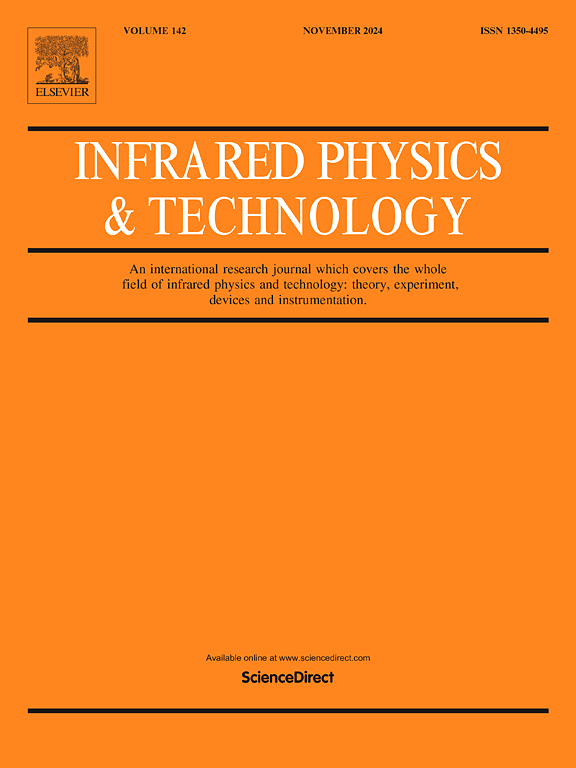具有Au超表面的Ge/ZnO多层膜的复合结构增强红外反射和兼容微波透明度
IF 3.1
3区 物理与天体物理
Q2 INSTRUMENTS & INSTRUMENTATION
引用次数: 0
摘要
抑制目标红外辐射特征和增强其环境自适应伪装能力一直是红外热管理技术的关键研究目标,本研究提出了一种由锗(Ge)/氧化锌(ZnO)多层膜(MLF)和Au方周期阵列(ASPA)组成的超表面复合多层膜(CMF),通过协同设计实现了高红外反射率和高微波透过率。对于红外波段,优化厚度的Ge/ZnO交替层满足Bragg反射条件,利用高/低折射率材料之间的建设性干涉来实现宽带高反射率。超薄金周期阵列作为辅助反射器,通过金属固有的红外反射率和密集的亚波长排列抑制传输损耗,从而拓宽反射带宽。在微波波段,特别设计的超薄金超表面实现了与自由空间的阻抗匹配,展示了高效的微波传输。实验和仿真结果表明,该复合结构在3-5µm波段和8-14µm波段的平均红外反射率分别达到94.1%和89.1%,在2-15 GHz频段具有超过85%的高效透射特性,在15-18 GHz频段保持了75 - 85%的较高透射效率。通过红外干扰和微波超表面共振的结合,解决了传统材料在热管理和通信中的不兼容性问题,为设计多功能卫星热控制和信号传输集成材料提供了一种新的途径。本文章由计算机程序翻译,如有差异,请以英文原文为准。
Composite structure of Ge/ZnO multilayer films with Au metasurface for enhanced infrared reflection and compatible microwave transparency
Suppressing target infrared radiation signatures and enhancing their environment-adaptive camouflage capability have remained key research objectives in infrared thermal management technologies, this study proposes a metasurface-based composite multilayer film (CMF) composed of germanium (Ge)/zinc oxide (ZnO) multilayers (MLF) and an Au square periodic array (ASPA), achieving high infrared reflectivity and high microwave transmittance through synergistic design. For the infrared band, alternating Ge/ZnO layers with optimized thicknesses satisfy Bragg reflection conditions, leveraging constructive interference between high/low refractive index materials to achieve broadband high reflectivity. The ultrathin Au periodic array acts as an auxiliary reflector, suppressing transmission losses via the intrinsic infrared reflectivity of metals and dense subwavelength arrangement, thereby broadening the reflection bandwidth. For the microwave band, specially designed ultrathin Au metasurfaces achieve impedance matching with free space, demonstrating high-efficiency microwave transmission. Experimental and simulation results demonstrate that the proposed composite structure achieves average infrared reflectance of 94.1 % in the 3–5 µm band and 89.1 % in the 8–14 µm band, while exhibiting efficient transmission characteristics exceeding 85 % in the 2–15 GHz frequency range and maintaining relatively high transmittance efficiency of 75–85 % in the 15–18 GHz band. By integrating infrared interference and microwave metasurface resonance, this work resolves the incompatibility of conventional materials in thermal management and communication, offering a novel approach to designing multifunctional integrated satellite materials for thermal control and signal transmission.
求助全文
通过发布文献求助,成功后即可免费获取论文全文。
去求助
来源期刊
CiteScore
5.70
自引率
12.10%
发文量
400
审稿时长
67 days
期刊介绍:
The Journal covers the entire field of infrared physics and technology: theory, experiment, application, devices and instrumentation. Infrared'' is defined as covering the near, mid and far infrared (terahertz) regions from 0.75um (750nm) to 1mm (300GHz.) Submissions in the 300GHz to 100GHz region may be accepted at the editors discretion if their content is relevant to shorter wavelengths. Submissions must be primarily concerned with and directly relevant to this spectral region.
Its core topics can be summarized as the generation, propagation and detection, of infrared radiation; the associated optics, materials and devices; and its use in all fields of science, industry, engineering and medicine.
Infrared techniques occur in many different fields, notably spectroscopy and interferometry; material characterization and processing; atmospheric physics, astronomy and space research. Scientific aspects include lasers, quantum optics, quantum electronics, image processing and semiconductor physics. Some important applications are medical diagnostics and treatment, industrial inspection and environmental monitoring.

 求助内容:
求助内容: 应助结果提醒方式:
应助结果提醒方式:


